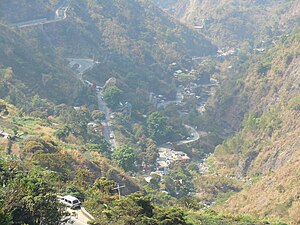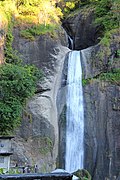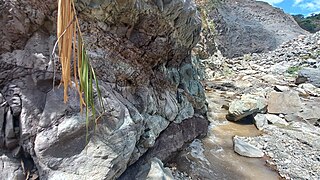
Baguio, officially the City of Baguio, is a 1st class highly urbanized city in the Cordillera Administrative Region, Philippines. It is known as the "Summer Capital of the Philippines", owing to its cool climate since the city is located approximately 4,810 feet above mean sea level, often cited as 1,540 meters in the Luzon tropical pine forests ecoregion, which also makes it conducive for the growth of mossy plants, orchids and pine trees, to which it attributes its other moniker as the "City of Pines".
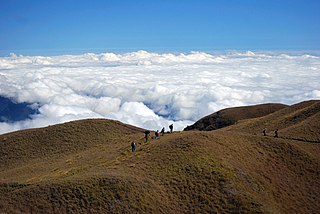
Benguet, officially the Province of Benguet, is a landlocked province of the Philippines located in the southern tip of the Cordillera Administrative Region in the island of Luzon. Its capital is La Trinidad.

Epifanio de los Santos Avenue, commonly referred to by its acronym EDSA, is a limited-access circumferential highway around Manila, the capital city of the Philippines. It passes through 6 of Metro Manila's 17 local government units or cities, namely, from north to south, Caloocan, Quezon City, San Juan, Mandaluyong, Makati, and Pasay.

Atok, officially the Municipality of Atok,, is a 4th class municipality in the province of Benguet, Philippines. According to the 2020 census, it has a population of 19,218 people.

Tuba, officially the Municipality of Tuba,, is a 1st class municipality in the province of Benguet, Philippines. According to the 2020 census, it has a population of 48,312 people.

Session Road is a six-lane 1.7-kilometer (1.1 mi) major road in Baguio, Philippines. The entire road forms part of National Route 231 (N231) of the Philippine highway network.

Mount Cabuyao is a mountain in the Philippines located in the municipality of Tuba in the province of Benguet. Its summit, rising to more than 2,000 metres (6,600 ft) above sea level, overlooks the city of Baguio. It is commonly mistaken as Mount Santo Tomas, a taller mountain just beside it.

The Tarlac–Pangasinan–La Union Expressway (TPLEX), signed as E1 of the Philippine expressway network and R-8 of the Metro Manila arterial road network, is a controlled-access toll expressway that connects the Central Luzon region with the Ilocos Region. From its northern terminus at Rosario in La Union to its southern terminus at Tarlac City, the expressway has a length of 89.21-kilometer (55.43 mi), cutting through the various provinces in northern Central Luzon. Despite that the name only stating the provinces of Tarlac, Pangasinan, and La Union, the expressway also passes the province of Nueva Ecija between Tarlac and Pangasinan, but without any exits to serve the said province.

Metro Baguio, also known as BLISTT, is an agglomeration of the city of Baguio and five municipalities of the Philippine province of Benguet, namely: La Trinidad, Itogon, Sablan, Tuba, and Tublay.

Lyman Walter Vere Kennon was a career United States military officer in active service from 1881 to 1918, attaining the rank of brigadier general. During the Spanish–American War Kennon was in command of Company "E" 6th Infantry Regiment and was cited for bravery at San Juan Hill. He was most recognized for his 1903–1905 work with the Corps of Engineers to lead the building of the Benguet Road, a mountain highway in the Philippines linking Rosario, La Union and the lowland areas to Baguio. During World War I, he commanded the military training facility at Camp Greene, North Carolina; the 171st Infantry, Brigade, Camp Grant, Illinois, and then the 86th Division, Camp Grant, Illinois.

The Halsema Highway is a national secondary highway in the Philippines. Situated within the Cordillera Central range in northern Luzon, it stretches from the city limit of Baguio to the municipality of Bontoc. Its highest point is at 7,400 feet (2,300 m) above sea level in the municipality of Atok. It was officially recognized as the highest altitude highway in the Philippines until 2019, when the 2.429-kilometer (7,970 ft) high point Kiangan–Tinoc–Buguias Road in Tinoc, Ifugao, was recognized as the new holder of the distinction.

The Lion's Head is a statue along Kennon Road, a major highway in Luzon, Philippines. Located in Camp 6 near the Baguio–Tuba boundary, the Lion's Head measures 40 ft (12 m) in height.

The Aspiras–Palispis Highway is a Philippine major highway in northern Luzon that runs from the city of Baguio in the province of Benguet to the municipality of Agoo in the province of La Union.

The Naguilian Road, officially the Quirino Highway and also known as the Baguio–Bauang Road, is a Philippine major highway in northern Luzon that runs from the city of Baguio in the province of Benguet to the municipality of Bauang in the province of La Union.
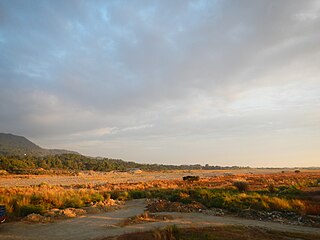
The Bued River is a river in the island of Luzon in the Philippines with a total length of 80 km (50 mi). It covers primarily the provinces of Benguet and Pangasinan, and a few parts of La Union. The river originates from the city of Baguio and joins with the Angalacan River in the municipality of Mangaldan, Pangasinan to form the Cayanga River.
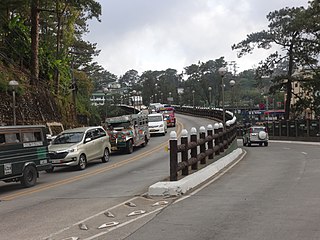
The Governor Pack Road is a major highway in Baguio, Philippines, named for the American William Francis Pack (1861-1944), who was appointed Military Governor of Benguet on November 15, 1901 and served as the civilian Governor of Mountain Province, in which Benguet was once part of as a subprovince, from 1909 to 1912.

The Asin–Nangalisan–San Pascual Road is a major road in La Union and Benguet, Philippines, serving as an alternative route to Baguio. This road is dangerous, and has tunnels along the way which used to be intended for rail services from Aringay to Baguio. The road officially opened to public on December 17, 2018.
The Benguet–Nueva Vizcaya Road,, is the road system that connects the provinces of Benguet and Nueva Vizcaya in the Philippines.
The Philippine highway network is a network of national roads owned and maintained by the Department of Public Works and Highways (DPWH) and organized into three classifications according to their function or purpose: national primary, secondary, and tertiary roads. The national roads connecting major cities are numbered from N1 to N83. They are mostly single and dual carriageways linking two or more cities.

Marquez "Mark" Ocampo Go is a Filipino businessman and politician. A member of the Nacionalista Party, he is the incumbent representative of the legislative district of Baguio since 2016. He is also an outstanding citizen of Baguio awardee in 1998.
